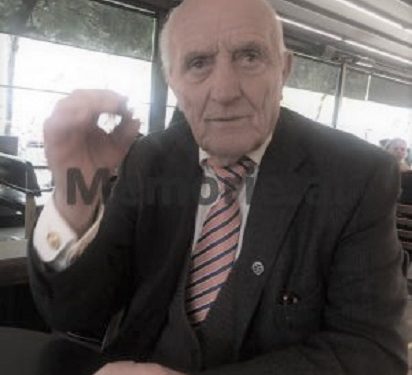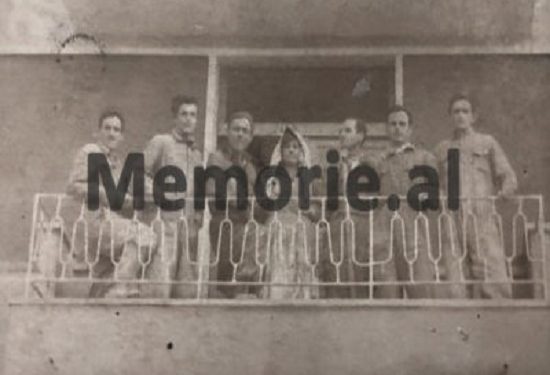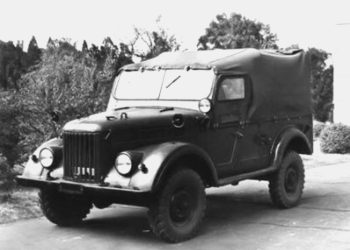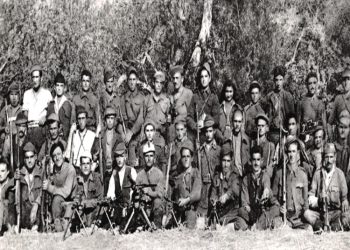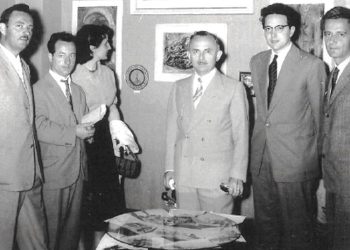Dashnor Kaloçi
Memorie.al publishes the unknown story of the Thumana prison camp (otherwise known as Ward 309), where hundreds of political prisoners were serving sentences for working to drain and rehabilitate that place, where in 1959 and the early 1960s There were several epidemics of diseases, such as that of Scurvy, Scabies, Tuberculosis and Dysentery, which affected about 400 to 500 convicts, respectively. The rare testimony of one of the prisoners of that camp, Mark Alisa, regarding those diseases that wreaked havoc in that prison camp with Commander Vangjel Rrëmbec from Korça, where for all those sick who were affected by those diseases, there was only five beds in the Nursing Prison where he served as a doctor political prisoner Mahmut Menko (sentenced to 20 years in prison, originally from the villages of Korça and graduated in Ioannina), who had no medical medication and the command told the convicts that ask their families for foods that contain vitamin C.
“Scurvy, which was a real epidemic for the large number of convicts affected, thus about 400 prisoners, came from malnutrition and lack of Vitamin C, which caused the weakening of the gums and as a result, our teeth fell out a by a. But that was half the evil, because when our teeth fell out we convicts could not consume that miserable food that was there and it was one of the most horrible tortures, as there is nothing worse than suffering hunger for a man. “As I said, this disease wreaked havoc on us, occupying about 400 convicts and without any treatment, as what was called the Nurse was a separate barracks with only five beds.” This is how 81-year-old Mark Gjon Alia, a former political prisoner, recalls the scurvy epidemic that struck the Thumana Swamp prison camp (also known as Ward 309) in 1959, which he said affected about 400 prisoners serving sentences there.
In this interview Mr. Alia tells us about Memorie.al about the epidemics of diseases of Scurvy, Scabies, Dysentery and Tuberculosis that fell in those years when he was serving his sentence near that prison camp, describing to us his condition and conditions, etc.
Mr. Mark, before we ask you and talk about the epidemics that have taken place in the Thumana prison camp, first tell us when and why you were arrested?
I was arrested for attempting to escape together with two of my friends (Javer Hoti and Rustem Berisha) on April 24, 1958, after they caught us somewhere near Shkodra and brought us to the Kruja Branch of Internal Affairs from where he was administratively dependent at the time. Mamurrasi, where my two friends and I lived.
Why did you decide to flee and how many years were you sentenced?
As I told you a little above, at the age of 17 I worked as an assistant with a group of Hungarian specialists and engineers led by Borç Lazlo who worked on the design of the reclamation and drying of the Thumana swamp, where I kept your lathes (instruments) and bags, I brought you water, bread and everything else they needed. In the various conversations they had, they also spoke openly with me against the communist regime of Enver Hoxha, as they were anti-communists and praised the western countries and the life that took place there. As it were, this was the first impulse I had to escape from Albania, which, as I told you, we could not do, because we were caught and after some time of investigation in the Internal Branch of Kruja, we were taken to court and initially sentenced me to 10 years in political prison on charges of “treason against the country remaining in the process of preparing to flee abroad” and confiscation of property and deprivation of the right to vote for five years. This sentence was upheld by the Military College of the High Court in Tirana, which convened on June 11 of that year, and after receiving the sentence, they sent us to the Thumana camp, where work had begun on drying up the swamp. So while I was a freelancer working with Hungarian specialists and engineers who designed water works to rehabilitate and drain that swamp, now as a prisoner I was sent to implement that project.
How do you remember the Thumana camp and when that prison camp was first opened?
The Thumana prison camp was called “Military Ward 309” and it was set up in 1958, after moving from Tërbufi, where political prisoners had worked to drain the swamp of the same name in the Myzeqe area. So the whole camp, with convicts and police and soldiers who had been in Tërbuf, moved there to Thumanë, as more or less the same work that had been done in Tërbuf would be done. The barracks, or as we called them, the barracks of the camp where the political prisoners would be housed, were set up somewhere in the place called “Kroi i sertë”, which is located very close to the Droja river in the village of Bushnesh, and they were built with planks covered with katrama. There were about 750 political prisoners, divided into labor brigades, while the soldiers and police guarding us were about 150 people serving inside and outside the three-barbed wire fence around the camp. But the number of prisoners was moving, as they kept bringing there and sometimes passing over 1000 or 1300 convicts, which made our life there even more difficult.
Who was the commander of that camp and under what conditions did you live and work there?
The commander of the camp was Major Vangjel Rrëmbeci (originally from Korça) who had been the commander of Burrel Prison before coming there. Conditions in that camp were miserable; starting with hygiene that I do not want to remind you is ashamed to write. Likewise the food that was hardly put in the mouth at all, because in addition to the 700 grams of cornbread they gave us as a daily ration, what was called a dish was made with leeks and cabbage and cooked with a kind of margarine caught by the Germans in their warehouses in in 1944 before they left Albania. So the food that was cooked there was almost never put in the mouth and if it were not for our families bringing us food, we would have starved to death or turned into living corpses. But I wanted to add that even that food was given to the prisoners only if they achieved the norm which was 17 cubic meters per day, so you had to do the work to get the food.
What was the work you did there?
The work we were doing was a torture in itself, as a prisoner had to open a canal by moving 17 cubic meters and, or rather mud and mud because that was the whole place there swamp and swamp. And in case you did not fulfill the norm, you were not given food and you were put in the dungeon as a punishment for not fulfilling the norm. The work was a real horror as in winter it was very harsh where there was frost and often we had to break the ice to open the canal, also the summer was hot and the sun was shining on us. The only working tools were shovels, spades, pickaxes and handcarts.
Were there prisoners who did not meet the norm or other sick people who could not work and how were they treated?
There were many who did not realize the norm due to physical impotence and they obeyed the rules of the command by entering the dungeons with various punishments that varied up to a month but even more for the repeaters. There were also many sick people and they left them in that condition in the infirmary and sent them to the hospital in Tirana, when they saw that they were in the last degree. So they sent them to the hospital in Tirana when they were close to death, so that they would not die there in the camp and panic would be created.
Since we are in this epidemic situation, we wanted to ask you, during the period that you were in that prison, were there any epidemic cases?
There have been several epidemics and I remember them very well, as the suffering we went through when those epidemics fell are not easily forgotten. Initially those epidemics have fallen since 1959 when I went there for the first time but also afterwards, such as the epidemics of Scurvy, Scabies, Tuberculosis and Dysentery which have affected hundreds of prisoners who we were serving the sentence there.
Where did those epidemics come from?
They fell only from the impurity that prevailed among all the convicts, as we lived there in miserable conditions, because in addition to the lack of food and scandalous sleeping conditions, etc., which I told them a little above, where there was no water that, was dripping. There was a lack of water for both drinking and bathing, as we had neither showers nor baths. So the miserable conditions where we were and the inhuman treatment we received, influenced us to be affected by those diseases that went as far as epidemics, such as that of 1959, where Scurvy’s disease wreaked havoc, capturing more than 400 convicts who were there.
Where did that disease come from and how was it possible to visit and treat such a large number of convicted persons?
Scurvy’s disease, which was a real epidemic for the large number of convicts affected, thus about 400 prisoners, came from malnutrition and lack of vitamins, especially vitamin C, which caused weakening of the gums and consequently, us our teeth fell out one by one, filling our mouths with blood. But that was half the evil, because when our teeth fell out we convicts could not consume that miserable food that was there and this was one of the most horrible tortures, as there is nothing worse than the torture of hunger for a man. As I said this disease wreaked havoc on us, occupying about 400 convicts and without any kind of treatment, as what was called the Nurse was a secluded barracks with only five beds.
How many doctors were there in the Thumana prison camp?
There was only one doctor, Dr. Mahmut Menko, originally from Korça who was convicted as well as us (political prisoner for 20 years), who had only a stethoscope to visit us and some aspirin or some other medicine that he gave us only when he was waiting for the bed sheet for in nursing and we were bed rest. Because that was the rules of the Prison Command In rare cases, they gave us a needle, so that we would not be absent from work, so that the daily norm would be realized. So everything was done in function of the norm.
Was he really a doctor, so he had graduated from the University of Medicine?
No, Mahmut had completed higher studies in Medicine during the time of the Bird Monarchy in Ioannina. I do not remember well other things about his life, because then I was very young, 17-18 years old and I did not have the opportunity to chat with Dr. Mahmutin, although he was a very humane man, very kind and respected by all the convicts.
But what did that doctor do to visit and treat about 400 prisoners who were affected by Scurvy or the epidemic as you say, or doctors came from Tirana?!
No doctor came from Tirana. Once a year, the doctor of the Ministry of Interior came from Tirana and not to visit us, but to get statistics on how many convicts had died and for what reasons and diseases their death had come. So only for statistical work and it was done not more for the health and life of convicts, but more for reasons of documentation from the economic point of view, if reconciliations of documentation for how many convicts were cooked.
How to visit and treat 400 sick deportees from Scurvy?!
Nothing was done, as Dr. Menko visited us and waited for us on the bed sheet as affected by Scurvy, we had the right to stay in bed mode in our plank silos without going to work.
What about medication…?
There was no question of medication, as there was no medical medication and based on this, the command told us to write letters to the families to drop us foods that had vitamin C., but the families of the political prisoners as well as the rest of the population, were in a very poor condition and could barely provide food for themselves. I remember that at the time of the Scurvy epidemic, our families brought us dried figs and wild or soft pomegranates to find, as they were said to have vitamin C. We chewed them without the need for teeth that we did not have them and with them we held our breath.
During that epidemic, were there any convicts who lost their lives there?
Yes, there were, there were many of them, unfortunately, and we, who survived that hell, made their names public in the press and in the books we wrote after the ’90s. We have all their names and these are also in the official documents for receiving compensation, etc. But I wanted to say that the command of the Thumana prison camp used a diabolical method to hide the number of people who lost their lives there due to diseases, as those who died in accidents could not be erased.
Specifically, what?
The sick convicts who were suffering from various diseases or epidemics, kept them there in the camp until the last moment and when they saw that they were hopeless, in the last degree, then they took them and sent them to the Hospital. Prison in Tirana, where they also died and we did not find out anything. Rare cases when someone came to visit us from the family and quietly told us about one of our compatriots who had died in prison, as not even in the letters dared to write about the dying prisoners. Because not only were those letters opened by the Command and not given to us, but it was called “agitation and propaganda” and the family member who wrote them was punished. Our people knew this and did not write or make such conversations in those few minutes of meeting, and so we did not know anything about what had happened to our compatriots who had lost their lives in the Tirana Prison Hospital, as neither the bodies were not given to the family without completing the sentence even as dead.
What about the other epidemics you mentioned like Tuberculosis, Scabies and Dysentery?
These epidemics have fallen after the 1960s when I was still there in prison, but unlike that of Scurvy, these were contagious diseases and from these we have suffered more by going through a real horror.
How many convicts are affected by these epidemics and how long did they last?
I say with moral responsibility that close to 400-500 convicts may have been affected by them and those epidemics lasted for several months. There were no accurate statistics, but around that figure revolves, as I recall entire silos that were filled with bed rest by convicts groaning without the necessary medication.
Do you remember any of your accomplices in that camp?
Definitely, I remember a lot even though more than 60 years have passed since then, I remember Rexh Meta, a senior official of Zog’s time who had worked in the Ministry of Finance, who worked as an escalator, so he did the escalation of the canal opened by the prisoners. I remember Miço Pilon from Saranda, who had studied at “Zosiema” in Ioannina and graduated in Athens where he worked as a lawyer. He was sentenced to 25 years in political prison. Another person I remember was Ceno Vermishi, a former major of the communist regime who was a political prisoner like us and was serving his sentence there, but unlike us, Ceno and many others like him, ie former officers or others who had been with various duties and functions in the communist regime, they worked there as brigadiers or in selected positions called privileged jobs. So even in prison there was differentiation and to those like Cenua, the command openly said: “You are ours”.
What about those houses, where did the prisoners of the camp work after the drying and reclamation of the Thumana swamp was finished?
After the reclamation of the Thumana swamp was completed, the prisoner camp was moved to the village of Gjorëm in Laç, or more precisely to the village of Sandzhak, which is only 3 km away away from the town of Laç which at that time was only a small village with a few houses, where we prisoners worked on the construction of the new camp housing, where the officers would live. Also at that time, the political prisoners of Gjormi Camp, built the first 12 palaces in the city of Laç where the first families that settled at that time were settled and then that town where only 3 km. farther away, on its very western side, another prison camp, (which had been relocated from the Rubik camp), I worked for several years for the construction of the Superphosphate Plant, which was inaugurated with great fanfare by the senior leadership of the ALP in 1967, attended by five or six members of the Politburo. While the prisoners of Gjormi Camp, after the construction of those 12 palaces of the city of Laç, worked hard for several years for the construction and opening of an irrigation canal that came from Milot and continued to Gjorm e Mamurras and the water that he brought, was used for irrigation of the whole buoy field on its western side.
When were you released from prison and where did you settle down for work?
I was released from prison on June 2, 1963 and a few days later I went to the town of Laç where the Industrial Construction Company had been established for some time, which in addition to some industrial works such as the Superphosphate Plant, where as I said was built by prisoners politics, he also built houses and palaces for the city of Laç that was coming and expanding. There I was immediately put to work in a brigade that was engaged in painting and housing, so I started working as a painter.
What about the ’90s?
With the fall of the communist regime in 1991, I was appointed Director of the Municipal Construction Enterprise of Kurbin district based in Laç and then the Ministry of Foreign Affairs in Tirana, with the position of Chief of Staff, from where left when the left came to power in 1997. At that time I returned to Mamurras where I was elected to the Municipal Council of Mamurras Municipality and as its deputy mayor for a term. Then I retired and had time to engage more with the Association of Former Prisoners and Politically Persecuted of Albania, participating in various activities conducted by that association or the Institute for the Rehabilitation of Former Prisoners and Persecuted Politics of Albania, the Authority of the Former State Security Files, etc. I have also written several books, mainly with memories of my comrades who suffered during the communist regime of Enver Hoxha./Memorie.al




